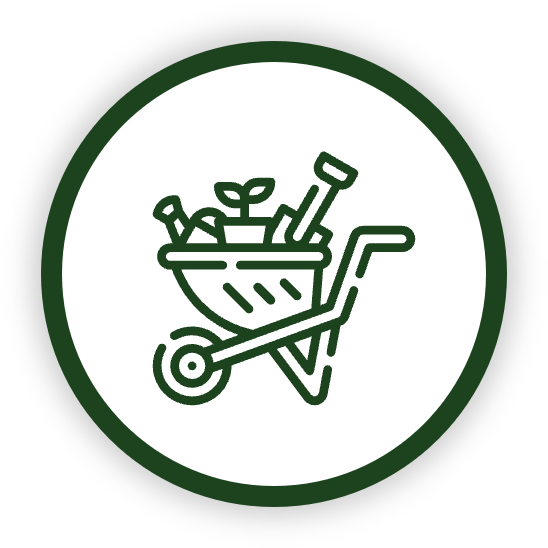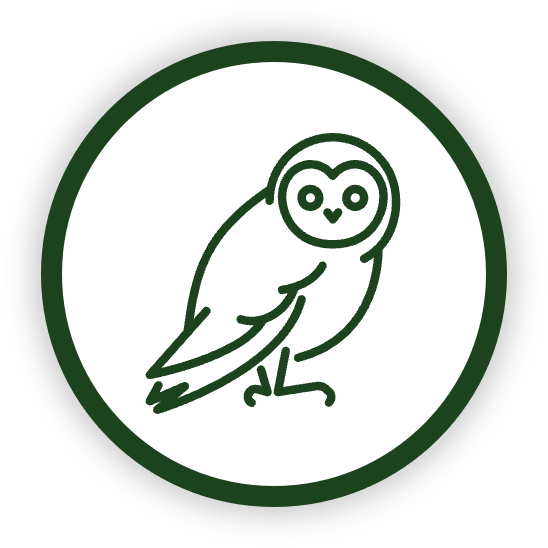2024 Q1 Impact Report
Letter from Founder and Team
The first quarter of the year is always a time of awakening from dormancy. This year started out with an intense cold snap, with the windchill, nearby areas got down to as low as -20F! But then it warmed into the 80s. As the soil thawed (and then re-froze, and then got snow, and then thawed into mud – but I digress) the seeds planted in the fall started to grow again. The soft soil allows for spring planting to begin. The trees start to leaf out again. The bees start to forage.
The beginning of this year also brought lots of opportunities for engagement and outreach. The Gulch’s Founder and Research Director had the opportunity to give the Opening Remarks at the Oklahoma Association of Conservation Districts annual meeting. This wonderful organization has been bringing together professionals working on land and soil conservation for generations; this year there were over 500 people representing around 140 organizations in attendance. At this same event, our Agricultural Advisor was presented with a prestigious conservation award at this meeting, the Oklahoma Leopold Conservation Award. The Gulch Foundation also had multiple opportunities for engagement with local University students. We presented about topics ranging from climate change to land conservation at a meeting for the Oklahoma State University (OSU) Environmental Science Club. We also attended the OSU Career Fair, making connections with students who might be interested in working at Rainmaker Farm.



The spring planting and fertilizing was started as well, with the front field being planted with oats for forage, and chicken litter being spread over the wheat field. Composted cattle manure was obtained towards the end of the quarter, and will be spread early in Q2.
We are continuing many of our infrastructure projects, from maintenance to completion of border trees, water catchment, and irrigation. Replacement trees for the border trees that did not survive our initial plantings were planted this quarter and are being cared for by a local arborist. These trees will provide a windbreak, as well as food and habitat for local wildlife.
During our February visit, areas of Texas relatively nearby were experiencing the largest wildfires in the history of the state. It resulted in stunning sunrises and sunsets in Oklahoma, but was also a stark reminder of how important conservation and climate mitigation work is these days.
Our projects are working to do good on multiple fronts: carbon sequestration, regenerating soil, make food for those in need, plant diverse crops for stability in changing times, and providing habitat to support our farm as part of the larger matrix of natural systems in the region.
We could not do our work without donors. Our foundation’s administrative costs are covered through sponsorship donations, and all other donations go directly to on the ground project actions.
Summary of Q1 Activities
Our donor-funded activities are broken down into 7 main categories. The activities completed during this quarter are outlined below:

University Involvement Support/ Science Projects
- Solicited applications for OSU students to be Gulch employees at the OSU career fair.
- Presented about climate change and land base carbon sequestration at the OSU Environmental Science club.
- Ongoing conversations with Oklahoma State University about participating in additional research projects, speaking events with students, and other opportunities for engagement.
- Baseline reports from biodiversity monitoring drafted.

Diverse Planting
- Perennial:
- We continued to care for the orchard trees.
- Roughly 50 orchard trees were planted in the orchard, both replacements for those that didn’t survive the first year and new varieties.
- We began the process of shifting the blueberry garden from the temporary straw bale beds, to between the border trees.
- Annual:
- Wheat: Q4 of 2023, we planted 33 acres of winter wheat in the south field, adjacent to the orchard. This wheat has germinated and is turning the fields green.
- Oats: This quarter we planted 30 ares of oats to be harvested as forage.

Livestock Incorporation
- Cattle and Chickens: This quarter, we incorporated livestock We obtained and spread 26 tons of chicken litter over the wheat field. We also obtained 200 tons of composted manure, and that will be spread that over part of the wheat field, the oat field, and the barley cover crop in Q2.
- European Honeybees: During a cold snap in January that brought temperatures down to near -20F with the windchill, our beekeeper needed to add insulation to the hive to protect the colony. The new more protected area also seemed to help, and the hive emerged from winter much stronger than last year. And as soon as temperatures warmed up, the honeybees started to emerge from the hive and begin foraging. The vetch cover crop we added is directly adjacent to the bees, and when this begins flowering, this should also provide a good source of food for stronger honey production this year.
- Beekeeper Zach visiting the farm in negative degrees to insulate the hives and keep the colony alive! Photo credit: Zachary Royko.

Cover Cropping
- Cover cropping is beneficial to regenerative farming in many ways. It protects the soil from erosion. Many species replenish essential nutrients, such as nitrogen, in the soil. This year we have three cover crops planted: Native grasses and barley from fall, and we have added hairy vetch this spring.
- Native grasses: The deep roots from native species also help sequester carbon. Our native grass cover crop around the orchard will continue to develop around the orchard, which will help with carbon sequestration, soil stabilization and retaining water in that soil.
- Barley: This quarter the 20-acres of barley cover crop we planted in our east field is starting to germinate. This cover crop was planted at nearly twice the density that would be planted at for growing grains. We also planted it during the fall, instead of during the spring as you would for grain. The intention behind this is so that in the early summer, before the barley seed has matured, we will roller/crimper this stand into a dense mulch to suppress the annual weeds. The mulch will also retain and slowly release nutrients as it decomposes over the course of the growing season. We can plant Milo into this dense thatch, right after it is crimped, and harvest the Milo in the fall.
- Hairy vetch: We planted 13 acres of hairy vetch near the honeybee hives, parallel to the riparian area of our creek. Vetch is a nitrogen fixing plant, and as it grows, this plant will enrich our soil. It’s flowers will also provide an excellent source of nectar for our honeybee colonies to produce abundant honey with. If the hairy vetch is planted in the fall, it can be used as a mulch with the roller crimper similar to the Barley. However, as ours was planted in the spring this year, the ability to use it as a mulch cover is more variable based on weather this spring. Therefore, in early summer we will determine if we are able to use it as mulch cover, or will mow it when we harvest the oats.

Farm Equipment & Supplies
- We have continued to make good use of the farm equipment purchased in earlier quarters, along us to do farm work and planting at the most optimal times for us.

Infrastructure
- We obtained the trees to complete our border of Rainmaker Farm along the roadways, as well as trees to replace the border trees that didn’t survive from the initial planting. Many of these were planted this quarter, and the remainder will be planted early in Q2.
- We ordered a mix of native and ornamental shrubs and vines to that are good for pollinators, fill in the understory of our border tree hedgerow. These will be planted during the Q2 Farm Day event.
- Our sole external water hydrant got run over, so that line got capped, and we obtained quotes to install 3 hydrants throughout the farm at better locations, including by the barn and greenhouse, and closer to the Tiny House (out of the pathway of vehicles). The hydrants will likely be installed early in Q2 .
- We have continued to develop a water catchment system, and met with contractors to design the catchment structure over the tank. We also met with an irrigation specialist about providing plans for an orchard irrigation system based on the water catchment tank, and will obtain an estimate from them in Q2.

Rainmaker Farm
- Ongoing monitoring of the Barn Owl Nest boxes Rainmaker Farm is using ecological pest management.
- We have been implementing a variety of Integrated Pest Management tools to manage the weedy or invasive species in our crops. We are using concentrated vinegar to treat the musk thistle again this year, but are starting when they are at the rosette stage to hopefully prevent the plant from living off of stored energy in the root systems from later stage treatments. The first vinegar treatment was applied in Q1. We will also use volunteers to help dig up this species by the roots at the next Farm Day for the rosettes that still resprout.
- We have released our annual report, available on our website.
Targets and Goal Tracking
We are on track to meet our targets and goals.
Next Steps
In Q2 2024 we anticipate the following:
-
- Farm Day event
- Meet with NRCS re: development of a Conservation Plan
- Continue developing the water catchment system.
- Explore partnering with researchers and educators at the University.
- Continue our outreach and education efforts.
